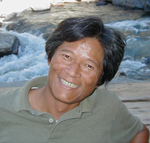Surface Acoustic Waves on Non-Piezoelectric Substracts for Sensing
EECS Colloquium
Featuring Chin Lee, Ph.D.
Department of Electrical Engineering and Computer Science
The Henry Samueli School of Engineering, UC Irvine
Location: McDonnell Douglas Engineering Auditorium
Free and open to the public
Abstract
The technology of surface acoustic waves (SAW) is widely used in applications such as detection of surface cracks or flaws, touch-panels, and SAW filters. The propagation of SAWs on the surface of solid materials has been used to detect hidden cracks and surface discontinuities in a medium. The SAW is readily attenuated when a soft object touches the surface of the medium.
For a piezoelectric material, SAWs can be generated using a transducer of interdigitated electrodes fabricated on the surface. However, most materials are non-piezoelectric. A method to produce SAWs on a non-piezoelectric material is to convert from bulk acoustic waves using the equivalence of Snell’s law in Optics. To satisfy the Snell’s law, longitudinal bulk wave propagating in the acoustic prism must be slower than the SAWs on the non-piezoelectric material. This poses a challenge because the SAW velocity is approximately 60% of longitudinal wave velocity in the same material. It is very hard to find a material in which the longitudinal wave velocity is slow and the propagation loss is acceptable.
Lucite is identified as meeting the low longitudinal wave velocity requirement. Acoustic right-angle prisms with angles satisfying the Snell’s law are made of Lucite. One right-angle face is bonded with a piezoelectric transducer and the hypotenuse face is bonded to a substrate such as soda-lime glass. Another transducer-prism assembly is also bonded to the glass to detect SAWs. The total loss from the transmitter to the receiver is measured. The SAW velocity is also measured and compared with calculated value.
Besides Lucite, we have continued to search for other acoustic prism materials that have better CTE (coefficient of thermal expansion) match and better acoustic impedance match to both the glass and the transducer. Bismuth and liquid crystal polymer (LCP) prisms have been identified and studied.
About the Speaker
 Chin C. Lee was born in Taiwan. He received B.E. and M.S. degrees in electronics from National Chiao-Tung University, Taiwan, and a Ph.D. degree in electrical engineering from Carnegie Mellon University.
Chin C. Lee was born in Taiwan. He received B.E. and M.S. degrees in electronics from National Chiao-Tung University, Taiwan, and a Ph.D. degree in electrical engineering from Carnegie Mellon University.He is a professor of electrical engineering and computer science at the University of California, Irvine, director of the Materials and Manufacturing Technology graduate concentration, and associate chair of the EECS department. His research interests include semiconductor devices, microwave devices, electronic packaging, thermal design of electronic devices, bonding technology, electromagnetic theory, acoustics, integrated optics, and optoelectronics. He has co-authored more than 200 papers.
Chin C. Lee is an associate editor of the Institute of Electrical and Electronics Engineers (IEEE) Trans. Components and Packaging Technologies, and since 1998, has served on the program committee of the IEEE Electronic Components and Technology Conference (ECTC). He was the chair of the ECTC Materials and Processing subcommittee. He also serves as the vice chair of IEEE-CPMT (components, packaging and manufacturing technology society) Technical Committee 5 - Materials and Processing.
He is a Fellow of IEEE, a Fellow of the Photonics Society of Chinese-Americans, and a member of Tau Beta Pi. He received the best paper award for a paper "Diagnosis of hybrid microelectronics using transmission acoustic microscopy" in 1979 IEEE Reliability Physics Symposium. He also received the 1985-86 outstanding assistant professor award from the School of Engineering at UC, Irvine. He is listed among 250 highly cited researchers in the engineering category of the Thomson-ISI (Institute of Scientific Information) Citation Database. He received the 2007 IEEE CPMT exceptional technical achievement award.
Please visit the EECS Colloquium website for a complete list of lectures.
Share
Upcoming Events
-
EECS Seminar: Less Compute, More Intelligence – Efficient and Autonomous Generative AI and Agents
-
MAE 298: Microscopic Robots that Sense, Act and Compute
-
CBE 298 Seminar: Interface Modification for Electrocatalysis
-
CEE Ph.D. Defense Announcement: Machine Learning and Remote Sensing for Environmental Modeling - From Large-Scale Streamflow Forecasting to Malaria Risk Mapping
-
CBE Special Seminar: Operando Electrochemical Methods at Dynamic Energy Materials Interfaces
